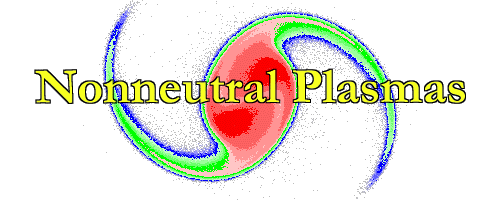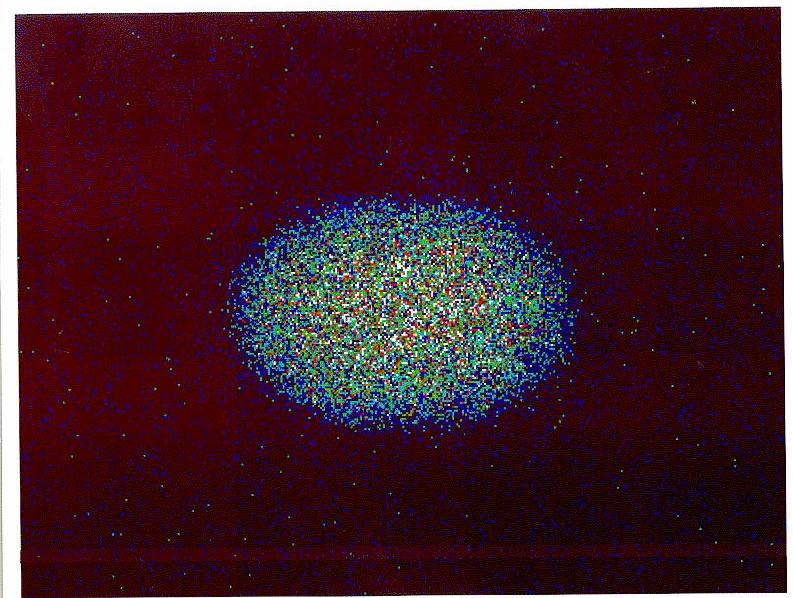
Theoretical Work



Despite their relative simplicity, these plasmas display a wide range of collective phenomena, and they are suitable for testing many important questions in plasma phyiscs. The UCSD plasma group has pioneered the study of these systems, and has used them for experimental and theoretical research on equilibrium, waves, 2D fluid dynamics,statistical mechanics and particle transport. Research on these plasmas has produced and will continue to produce paradigms for understanding the more complex behavior typical of laboratory and naturally occuring plasmas. It has opened for experimental study new regimes of plasma physics, such as the regimes of strong magnetization and strong correlation. Further, it contributes to and draws from atomic physics, condensed matter physics and fluid physics.
Recent experiments on the cryogenic electron trap have extended measurements of collisional thermalization into the strongly magnetized regime, resulting in striking verification of a new many-particle adiabatic invariant. Thermalization processes are now being analyzed in the regime where inter-particle correlations are important, including the crystallized regime. This work may have application to efforts to produce anti-hydrogen, to cryogenic ion clusters for time-standards, and to storage rings.
Transport of Particles across magnetic fields due to viscosity from interparticle collisions is a major area of research we study. Both compressional viscosity, which acts on length changes driven by plasma rotation in asymmetric confinement potentials, and shear viscosity, which acts on spacial variations in the the plasma rotation. Data from the new laser-diagnosed ion apparatus may clarify the role of velocity resonances in these transport processes. These processes are also important in neutral confinement, but have not been previously tested quantitatively.
A new stability theorem based on maximum, rather than minimum, energy states is being developed. The new theorem requires that collisionless ExB drift dynamics predominate, but it does not require cylindrical symmetry of the apparatus or plasma. Recently, long-lived non-axisymmetric states have been observed experimentally, consistent with the theorem. This theorem will be extended to toroidal geometry and partially neutralized (e.g. electron-positron) plasmas.
In the 2D ExB drift limit, the plasma flow is the same as that of an incompressible 2D ideal fluid, and this analogy will be used in experiments on 2D vortices and turbulence. Nonlinear processes in vortex dynamics which cannot readily be measured in conventional fluids such as water will be investigated. We compare maximum entropy and minimum enstrophy predictions for the final state of turbulence to data from a new camera-diagnosed electron apparatus. Interestingly, experiments show that turbulence can lead to a crystalline pattern of vortices, and this novel behavior will be explored experimentally and theoretically.
Non-neutral plasmas can be confined in a state of global thermal equilibrium; and plasma, liquid, and crystal phases have been observed. The theory of the 3D crtstal structure and oscillatory modes of confined cryogenic ion plasmas is pursued in the low, but non-zero temperature regime. Here, the effects of boundaries, correlations, and mode nonlinearities are all important for experiments in several groups. Along similar lines, the interactions between charged grains in "dusty plasmas" is analyzed in the regime of strong correlation.
Finally, research on the nonlinear interaction between a bean and resonant waves will be continued, using the travelling wave tube apparatus. This interaction is traditionally described by quasilinear theory, which neglects the effects of mode couplings. Recent experiments have established that mode couplings are significant, but that they do not strongly change the wave growth rates. Future experiments will attempt to characterize the nonlinear beam-phase-space structures which develop. Results on this simple system may aid understanding of more complicated beam-plasma interactions.




